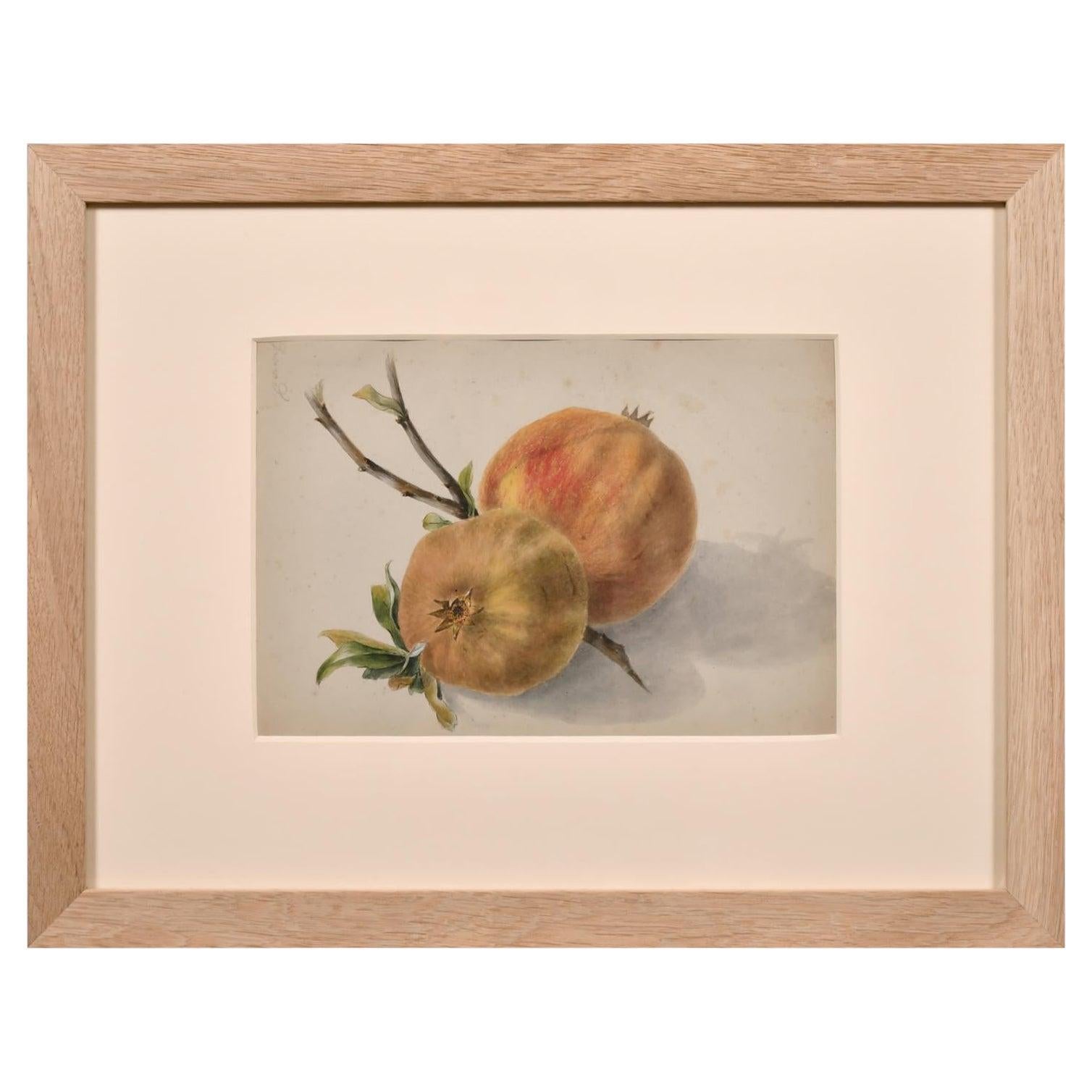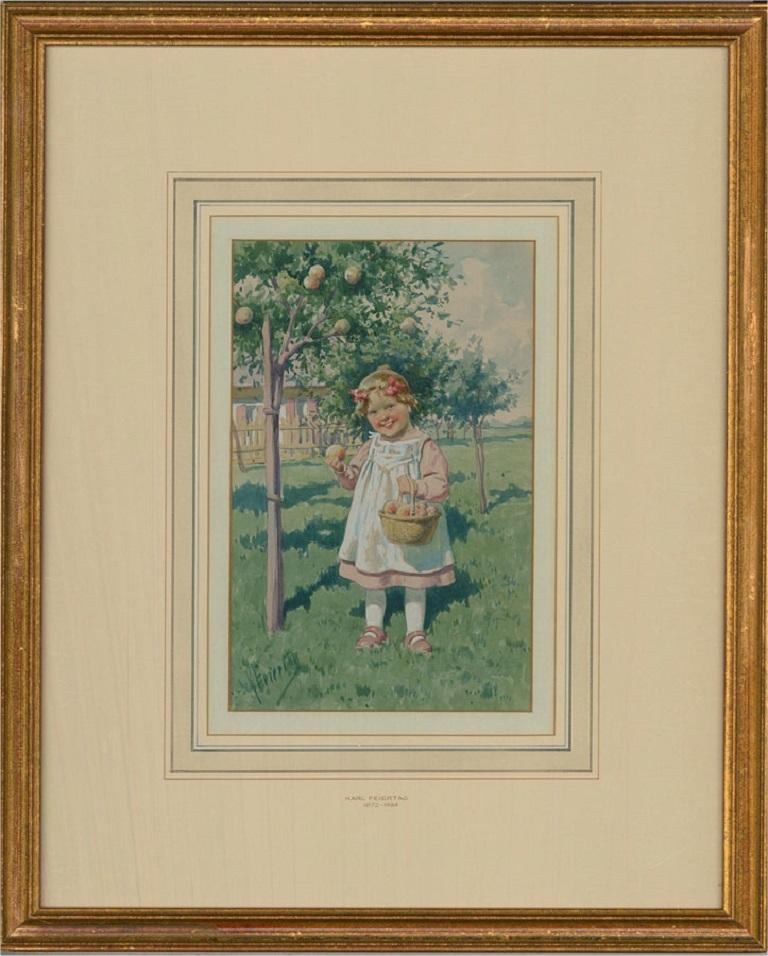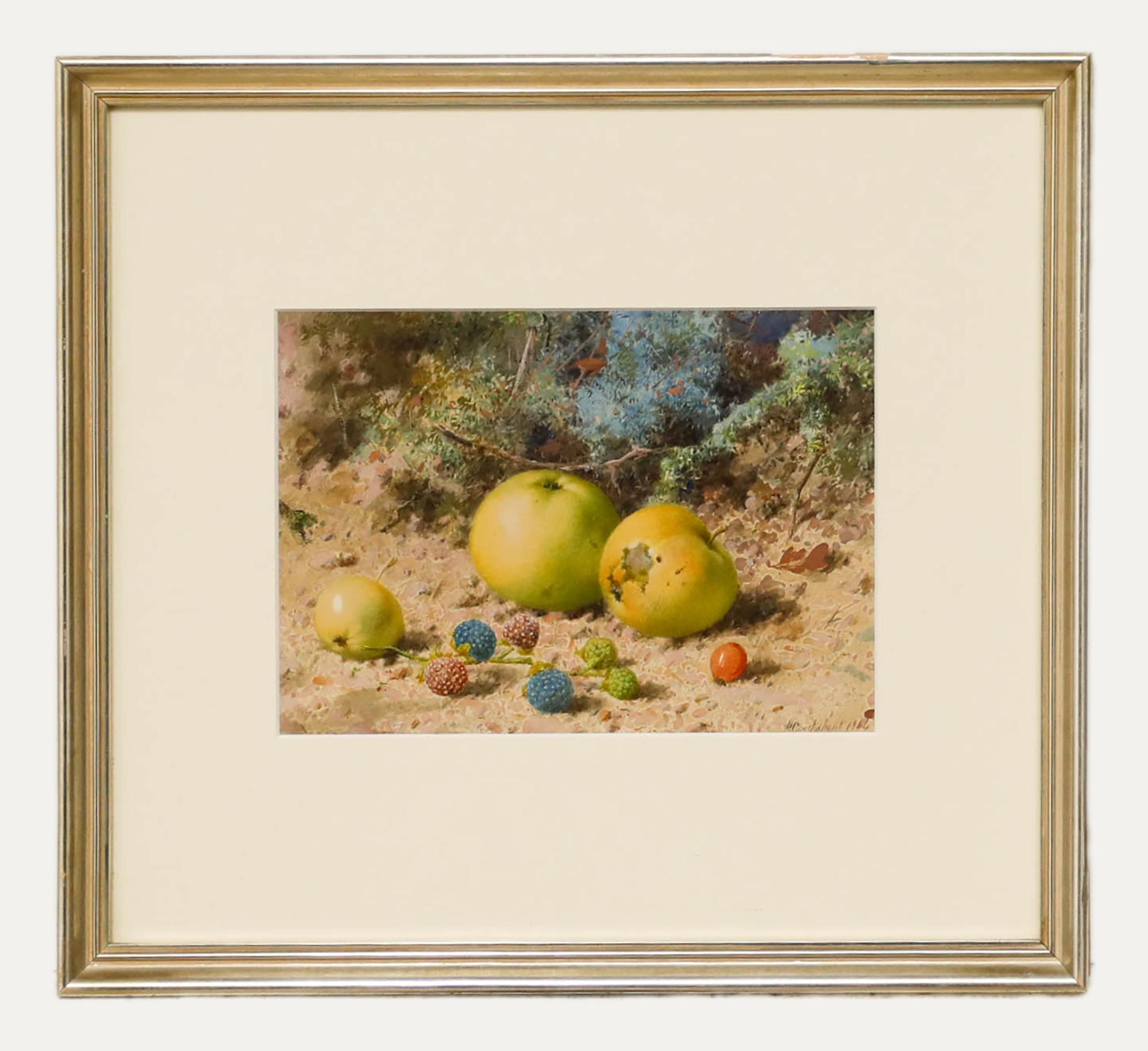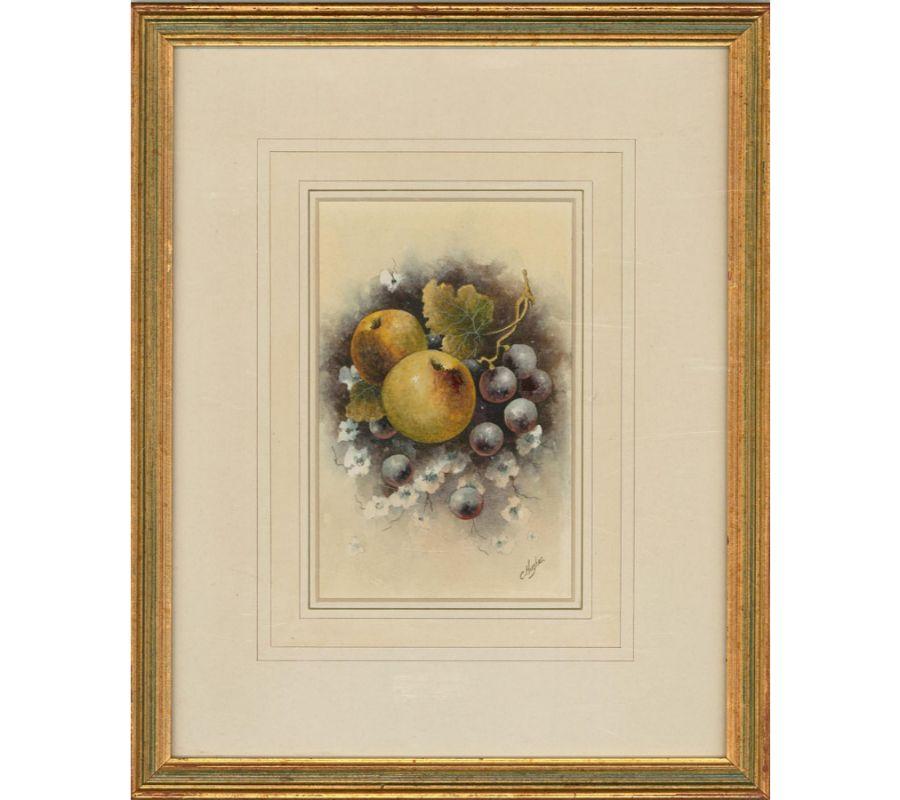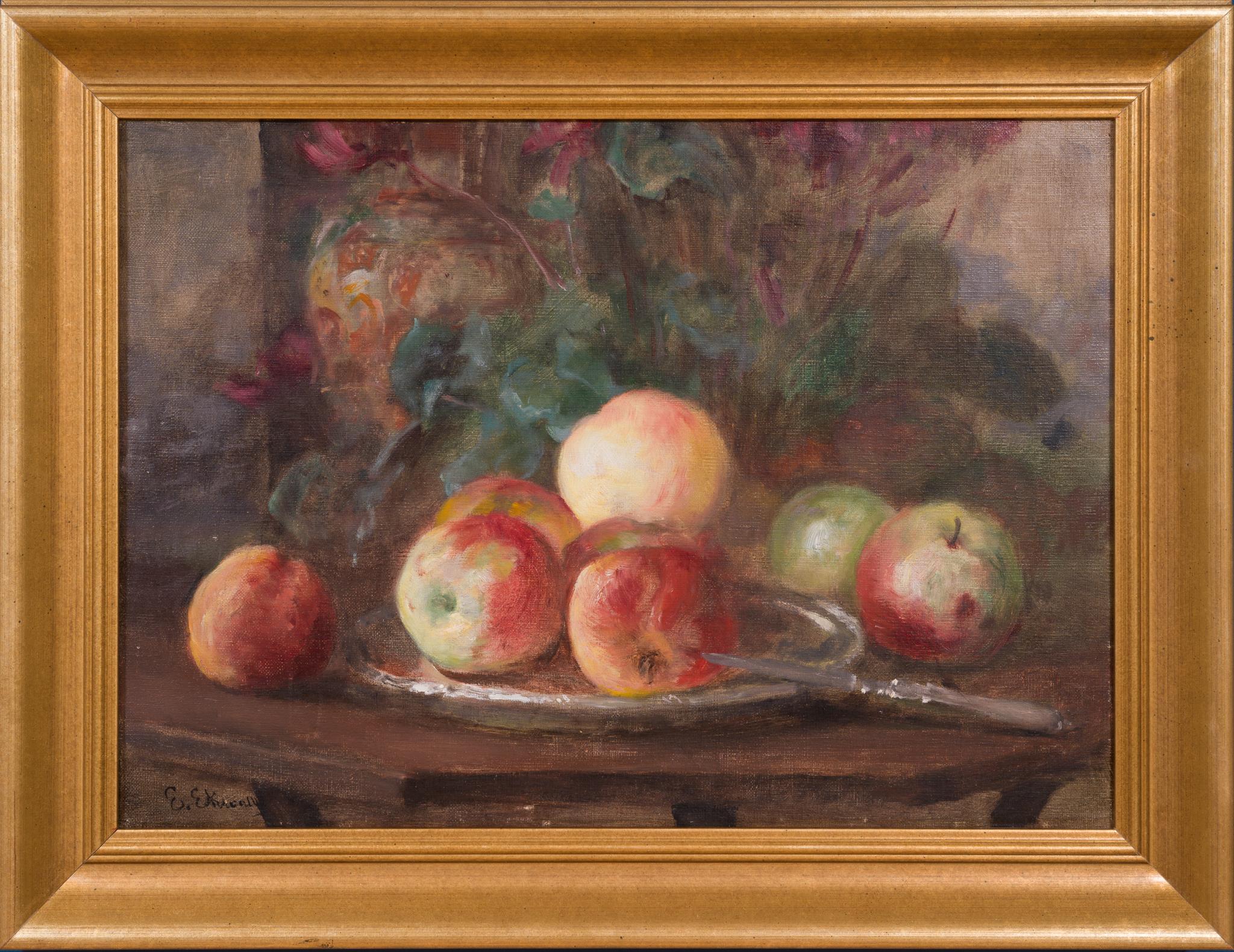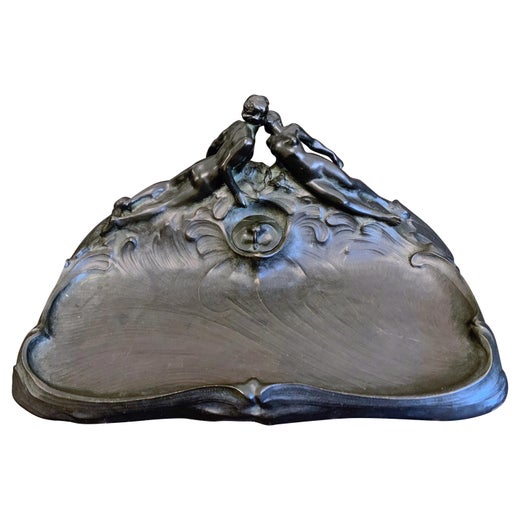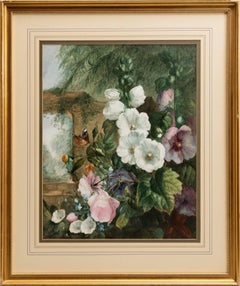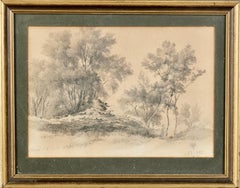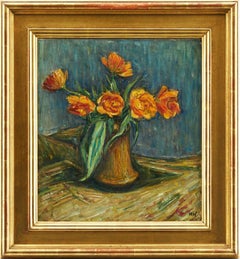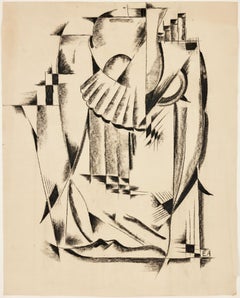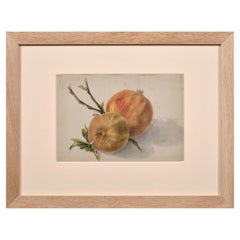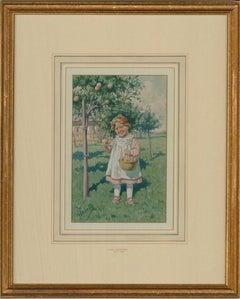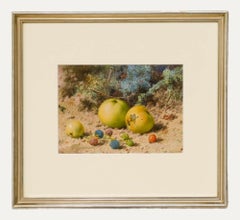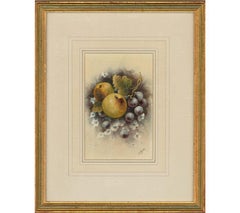Items Similar to Tree Branch With Apples, Watercolor, 1895
Want more images or videos?
Request additional images or videos from the seller
1 of 8
Otto StrandmanTree Branch With Apples, Watercolor, 18951895
1895
$889.94
£660.55
€750
CA$1,234.77
A$1,383.44
CHF 719.45
MX$16,761.38
NOK 9,166.08
SEK 8,556.86
DKK 5,710.56
About the Item
A Branch with Apples, watercolor and gouache on paper by Swedish artist Otto Strandman (1871–1960). The composition features a delicately rendered branch with green and reddish apples, capturing the subtle interplay of light, texture, and natural color variations. The painting is signed and dated with Strandman’s monogram OS interlinked, and SEPT 7, 1895. His expertise as a sculptor is evident in the three-dimensional quality of the apples and leaves, giving the piece a lifelike presence. The work exemplifies his skill in both painting and observation, showcasing his deep understanding of form and nature.
Otto Strandman (1871–1960) – Swedish Painter and Sculptor
Otto Strandman was a versatile Swedish artist, renowned for his achievements in both painting and sculpture. He received his artistic education at the College of Design and Crafts in Gothenburg before continuing at the Royal Academy of Fine Arts in Stockholm from 1891 to 1895. In the same year, he was awarded the prestigious King’s Medal. Seeking further artistic development, he later studied in Germany, Italy, and Paris in 1899, immersing himself in various artistic traditions.
Though primarily recognized as a sculptor, Strandman also excelled in painting. He worked in oil and watercolor, producing portraits, landscapes, animal studies, and still lifes. His knowledge of sculpture provided a unique dimensionality to his painted subjects, as seen in our Branch with Apples, where the fruits and foliage appear almost tangible.
Beyond painting, Strandman created reliefs, busts, and numerous small-scale decorative artworks, hand mirrors, goblets, and jewelry in precious metals. His artistic versatility extended to teaching—he worked as an instructor at the Royal Institute of Technology in Stockholm in 1907 and became a member of the Royal Academy of Fine Arts in 1915.
In 1914, he held a major exhibition in Stockholm, presenting his sculptures, paintings, and drawings. One of his most notable public works is the bronze bust of Gustav II Adolf, which was unveiled by Crown Prince Gustaf Adolf in 1924 in Umeå.
Strandman’s works are housed in prestigious collections, including the National Museum and the Royal Library in Stockholm, as well as the Trelleborg Museum, Norrköping Art Museum, and Västerås Art Museum.
Throughout art history, the apple has carried deep symbolic meanings—representing knowledge, temptation, immortality, love, and beauty. In A Branch with Apples, Strandman captures these themes, elevating a simple subject into a timeless and evocative work of art.
A beautifully painted branch with green and reddish apples by Otto Strandman (1871-1960). Signed with monogram 'OS' and dated '7 SEPT. 1895'. Watercolor and gouache on paper.
Otto Strandman received his education at the The College of Design and Crafts school in Gothenburg and the Royal Art Academy in Stockholm 1891–1895, and then in Germany, Italy and Paris in 1899. He won the King's Medal in 1895. In 1907 he worked as an extra teacher at the Royal Technical University in Stockholm and in 1915 he became a member of the Royal Academy of Fine Arts.
Mostly he became known as a skilled sculptor. He created reliefs, as well as many small sculptures and art-industrial objects such as electric lamps, hand mirrors, goblets and jewelry in precious metals. He has also painted in oil and watercolor, portraits, animal studies, landscapes and floral still lifes. With the knowledge as a sculptor, he could give that extra dimension to a subject on painted surface as in the present watercolor of a branch with apples.
In 1914, he exhibited all his sculptures, paintings and drawings in Stockholm. His bust of Gustav II Adolf in Umeå was unveiled by Crown Prince Gustaf Adolf in 1924.
Strandman is represented in several museums, including Trelleborg Museum, Norrköping Art Museum and Västerås Art Museum, as well as in the Royal Library and the National Museum in Stockholm.
Popular Christian tradition holds that Adam and Eve ate an apple from the forbidden tree in the Garden of Eden. As a result, the apple became a symbol for knowledge, immortality, temptation, love, beauty, the fall of man and sin.
- Creator:Otto Strandman
- Creation Year:1895
- Dimensions:Height: 15.75 in (40 cm)Width: 11.42 in (29 cm)Depth: 1.19 in (3 cm)
- Medium:
- Movement & Style:
- Period:
- Condition:Minor discolorations.
- Gallery Location:Stockholm, SE
- Reference Number:1stDibs: LU2608213877372
Otto Strandman
Otto Strandman was an Estonian politician who served as Prime Minister and State Elder of Estonia. Strandman was born on 30th November 1875, in the village of Vandu, Undla Parish, Viru County, then part of the Governorate of Estonia of the Russian Empire. His father, Hans Strandman, was a school teacher, and Otto was his third child.
About the Seller
5.0
Gold Seller
Premium sellers maintaining a 4.3+ rating and 24-hour response times
1stDibs seller since 2023
22 sales on 1stDibs
Typical response time: <1 hour
- ShippingRetrieving quote...Shipping from: Stockholm, Sweden
- Return Policy
Authenticity Guarantee
In the unlikely event there’s an issue with an item’s authenticity, contact us within 1 year for a full refund. DetailsMoney-Back Guarantee
If your item is not as described, is damaged in transit, or does not arrive, contact us within 7 days for a full refund. Details24-Hour Cancellation
You have a 24-hour grace period in which to reconsider your purchase, with no questions asked.Vetted Professional Sellers
Our world-class sellers must adhere to strict standards for service and quality, maintaining the integrity of our listings.Price-Match Guarantee
If you find that a seller listed the same item for a lower price elsewhere, we’ll match it.Trusted Global Delivery
Our best-in-class carrier network provides specialized shipping options worldwide, including custom delivery.More From This Seller
View AllHollyhocks and Roses in a Garden with Butterfly
Located in Stockholm, SE
This is a beautiful and highly decorative watercolor painting, featuring a charming garden scene filled with pink and white hollyhocks alongside blooming roses. Nestled among the del...
Category
Late 19th Century Naturalistic Still-life Drawings and Watercolors
Materials
Paper, Watercolor
Narni Landscape Drawing
Located in Stockholm, SE
“Hilly landscape with trees and bushes from Narni in Italy,” sketched by Gustav Wilhelm Palm (1810–1890). Dated and signed “Narni 16 Sept” with “G.W [palm tree] 45,” it portrays gent...
Category
1840s Other Art Style Landscape Drawings and Watercolors
Materials
Paper, Pencil
Karl Nordström, Yellow Tulips, Signed and dated.
Located in Stockholm, SE
A beautiful still-life of yellow and red tulips in a vase by Karl Nordström (1855-1923), signed 'KN' and dated a tergo 1917. The vibrant flowers are standing in a vase which is placed on a cloth against a bluish-green background.
Karl Fredrik Nordström was born on the Swedish west coast on the large island of Tjörn and was a Swedish painter known mostly for his landscape paintings.
He came to Stockholm in 1875 and started to study at the
Royal Art Academy, where he was tutored by Edvard Perséus, among others. There, he also became close friends with the artists Richard Bergh and Nils Kreuger...
Category
1910s Expressionist Still-life Paintings
Materials
Canvas, Oil
Abstract Composition Drawing, Chinese Poem 1929
Located in Stockholm, SE
An interesting and highly decorative chalk drawing by Edvard Andersson, 1929. Drawn on a quite large scale. Signed and dated EA, 1929. A tergo written "Kinesisk dikt" (Chinese Poem)
...
Category
1920s Abstract Abstract Drawings and Watercolors
Materials
Paper, Chalk
Forest Meadow in the Bavarian Forest
Located in Stockholm, SE
An expansive twilight landscape unfolds before you: a dark spruce forest opens into a quiet forest meadow, the silence punctuated only by the fading light. In the distance, the Bavar...
Category
1920s Other Art Style Landscape Paintings
Materials
Canvas, Oil
Mothers Joy III, also called Maternal Delight III
By Anders Zorn
Located in Stockholm, SE
Maternal Delight III, or Mothers Joy III, (In Swedish Modersglädje III) by Anders Zorn depicting a young woman lovingly playing with her child. A small amusing detail is the small child face visible on the lower left side, just outside the oval. This is an extremely rare etching and is one of two or possibly three known in existence of a so called cancellation proof. A cancellation proof etching of the Maternal Delight III is in the Boston Public Library Collection, USA.
Signed Zorn in the plate. When Zorn decided that the vey limited number of prints were all done he took his burin, (the steel cutting tool used in engraving also, back in history, called graver), and made cross hatched lines across the figures on the original plate, after which he made a couple of after proofs or cancellation proofs and the present etching is one of them. This gives the present work a special and interesting image of one of Zorns best and rarest etchings. Created in London 1883, the first year he made etchings.
Etching 276 x 406mm
Sheet circa 33,5 x 48cm
Literature
Asplund 6. Delteil. 5. Hjert & Hjert 6. Lidbeck 6.
Unfortunately some reflexes in the photos.
Anders Zorn (1860-1920) was a Swedish artist who attained international success as a painter, sculptor, and etching artist. He was to become one of Swedens foremost artists ever. No technique was foreign to him, he worked equally well with watercolors, wash technique or oil painting. The etching technique also attracted this virtuoso and the etchings contributed greatly to his success.
Between 1875 to 1880, Zorn studied at the Royal Swedish Academy of Arts in Stockholm, where he amazed his teachers with his talent. Members of the Stockholm Society approached him with commissions. In early 1881, Zorn met Emma Lamm, whose background was quite different from his. Emma Lamm was from a wealthy Jewish merchant family. She was interested in art and culture and, after a long engagement, they were married in 1885.
During the 1880s Zorn traveled extensively, to London, Paris, the Balkans, Spain, Italy, and the United States. In the 1890s when he was in Paris, he spent much time with Albert Edelfelt. He quickly became an international success and one of the most highly regarded painters of his era. In the beginning of Zorns career, it was primarily his skill as a portrait painter that gained him international acclaim, based principally upon his incisive ability to depict the individual character of his model, he came to portray many great people including three American Presidents: Grover Cleveland, William H. Taft, and Theodore Roosevelt.
Zorn also depicted Swedish dignitaries, for example King Oscar II in 1898, King Gustaf V in 1909, Queen Sophia in 1909, Prince Eugen in 1891, fellow artist Carl Larsson in 1897 and August Strindberg in 1910.
In the late 1880s, Zorn began working in the genre that is probably his hallmark for the general public, nude studies in the open air. Zorn had long been fascinated by the movements of water and the reflections of light on the water surface. Now Zorn chose to place a nude model by or in the water, with the aim of depicting people in nature.
When Zorn started the art of etching, he developed a technique with Rembrandt as a model, where he built up the motif with bursts of lines. The first etching was created in London in 1883, the same year as our Maternal Delight. Axel Herman Hägg, then active in London, was Zorn's teacher in this special technique. Hägg was the person Zorn depicted in his first etching. Zorn quickly mastered the etching technique itself and a unanimous art expert was able to conclude early on that Rembrandt had now found his equal.
At the age of 29, he was made a Chevalier de la Légion d'honneur at the Exposition Universelle 1889 Paris World Fair.
Zorn's reputation as an etcher spread across the world. Soon he could find his etchings in the major world metropolises in Europe and the USA. Zorn produced 289 different etchings, including portraits, genre studies and nude studies.
The motifs on Anders Zorn's graphic sheets are most often based on his own paintings, as ours, which is based on a watercolor he made in 1882 on his first trip to Spain. Even during Zorn's lifetime, his etchings were considered to be artistically superior to his paintings. As a result, his graphics quickly became sought after on the international art market. He was compared to Rembrandt, who as mentioned earlier was Zorn's great role model in the art of etching. Zorn was able to combine the old technique with his personal form of impressionism and the temporary and everyday with the universal. On the printing plates, one can study his outstanding etching technique, his characteristic play with parallel lines drawn in different directions, with varying degrees of force and intensity.
Zorn's art made him wealthy and he was thus able to build up a considerable collection of art. In their joint will, Anders and Emma Zorn donated their entire holdings to the Swedish State.
Some of his most important works can be seen at the National Museum of Fine Arts in Stockholm. Other museums holding major works by Zorn include the Musée d'Orsay in Paris, the Metropolitan Museum of Art in New York, and the Museum of Fine Arts, Boston. The Zorn Collections located in Mora and Garberg, Älvdalen, consist of four museums dedicated to the life and works of Anders Zorn. Shown there are extensive works of Zorn and his collected art.
The Bellman Prize (Bellmanpriset) is a literature prize for "an outstanding Swedish poet", every year awarded by the Swedish Academy. The prize was established by Anders Zorn and his wife Emma in 1920.
The motif: The present etching is based on a central and important work from Zorns first important trip to Spain, 1881-1882. After visiting Madrid and Seville, Zorn set off for Cádiz, tempted by the sea and the city’s women who were reputed to be the most beautiful in all of Spain.
In Maternal Delight, also translated to Mothers Joy and Mothers Pride...
Category
1880s Other Art Style Portrait Prints
Materials
Paper
You May Also Like
Fine 19thc Botannical Watercolour Drawing - Two Red & Green Apples & Branch
Located in Cirencester, Gloucestershire
Artist/ School: English School, 19th century, indistinctly signed lower corner.
Title: botannical study of two apples with a branch next to them.
Medium: watercolour drawing on pap...
Category
Mid-19th Century Victorian Still-life Drawings and Watercolors
Materials
Acrylic
Karl Feiertag (1874-1944) - Austrian Early 20th Century Watercolour, Apple Tree
Located in Corsham, GB
A charming portrait of a little girl collecting apples from a tree. Presented glazed in a wash line mount and a distressed gilt-effect wooden frame. Signed to the lower-left corner. ...
Category
20th Century Figurative Drawings and Watercolors
Materials
Watercolor
William Cruikshank (1848-1922) - 1864 Watercolour, Apples and Berries
By William Cruikshank
Located in Corsham, GB
A fine watercolour study with gum arabic details depicting apples and berries in under bush. Signed and dated to the lower right. Presented in a silver gilt frame. On paper.
Category
Mid-19th Century Still-life Drawings and Watercolors
Materials
Watercolor
Christopher Hughes - 20th Century Watercolour, Apples and Grapes
By Christopher Hughes
Located in Corsham, GB
A fine watercolour painting with gouache details by the British artist Christopher Hughes, depicting a still life of apples and grapes. Signed to the lower right-hand corner. Well-pr...
Category
21st Century and Contemporary Still-life Drawings and Watercolors
Materials
Watercolor
French School Swags of Apples a Pair of Watercolour Paintings c1890
Located in Holywell, GB
Martin Jules CHOUARD (1839-1919) Swags of Apples a Pair of Watercolours c1890
A near pair of decorative watercolour paintings signed and presented in expensive stylish maple frames....
Category
1890s French School Still-life Drawings and Watercolors
Materials
Watercolor
Still Life with Apples, c. 1910
Located in Stockholm, SE
Still Life with Apples is an exquisite still-life painting that captures a quiet moment of abundance and peace. On a humble wooden table lies a cluster of ripe apples, their rosy and...
Category
1910s Realist Still-life Paintings
Materials
Canvas, Oil
